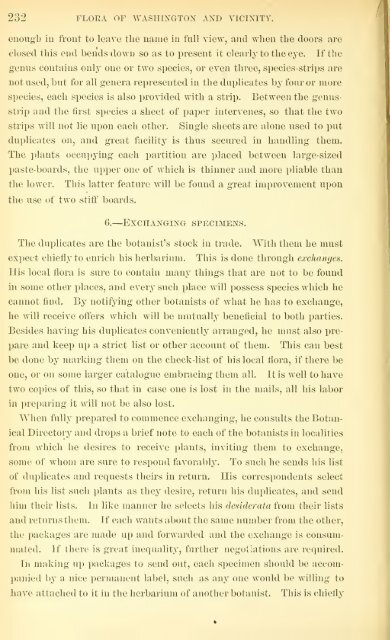Bulletin - United States National Museum - Smithsonian Institution
Bulletin - United States National Museum - Smithsonian Institution
Bulletin - United States National Museum - Smithsonian Institution
You also want an ePaper? Increase the reach of your titles
YUMPU automatically turns print PDFs into web optimized ePapers that Google loves.
232 FLORA OF WASHINGTON AND VICINITY.<br />
euoiigl) iu front to leave the name in fall view, and when the doors are<br />
closed this end bends down so as to present it clearly to the eye. If the<br />
genus contains only one or two species, or even three, species -strips are<br />
not used, but for all genera reijresented iu the duplicates by four or more<br />
species, each species is also provided with a strip. Between the genus-<br />
strip and the first species a sheet of paper intervenes, so that the two<br />
strips will not lie upon each other. Single sheets are alone used to put<br />
duplicates on, and great facility is thus secured in handling them.<br />
The plants occui)ying each i)artition are placed between large-sized<br />
paste-boards, the ui)per one of which is thinner and more pliable than<br />
the lower. This latter feature will be found a great improvement upon<br />
the use of two stiff boards.<br />
6.—EXCHANGINa SPECIMENS.<br />
The duplicates are the botanist's stock in trade. With them he must<br />
expect chiefly to enrich his herbarium. This is done through exchanges.<br />
His local flora is sure to contain many things that are not to be found<br />
in soDiC other places, and every such place will possess species which he<br />
cannot find. By notifying other botanists of what he has to exchange,<br />
he will receive offers which will be mutually beneficial to both parties.<br />
Besides having his duplicates conveniently arranged, he must also pre-<br />
pare and keep up a strict list or other account of them. This can best<br />
be done by marking them on the check-list of his local flora, if there be<br />
one, or on some larger catalogue embracing them all. It is well to have<br />
two copies of this, so that in case one is lost iu the mails, all his labor<br />
in preparing it will not be also lost.<br />
When fully prepared to commence exchanging, he consults the Botan-<br />
ical Directory and drops a brief note to each of tbe botanists in localities<br />
from which he desires to receive plants, inviting them to exchange,<br />
some of whom are sure to respond favorably. To such he sends his list<br />
of duplicates and requests theirs in return. His correspondents select<br />
from his list such plants as they desire, return his duplicates, and send<br />
him their lists. In like manner he selects his desiderata from their lists<br />
and returns them. If each wants about the same number from the other,<br />
the packages are made up and forwarded and the exchange is consum-<br />
mated. If there is great inequality, farther negotiations are required.<br />
In making up packages to send out, each specimen should be accom-<br />
panied by a nice permanent label, such as any one would be willing to<br />
have attached to it in the herbarium of another botanist. This is chiefly

















